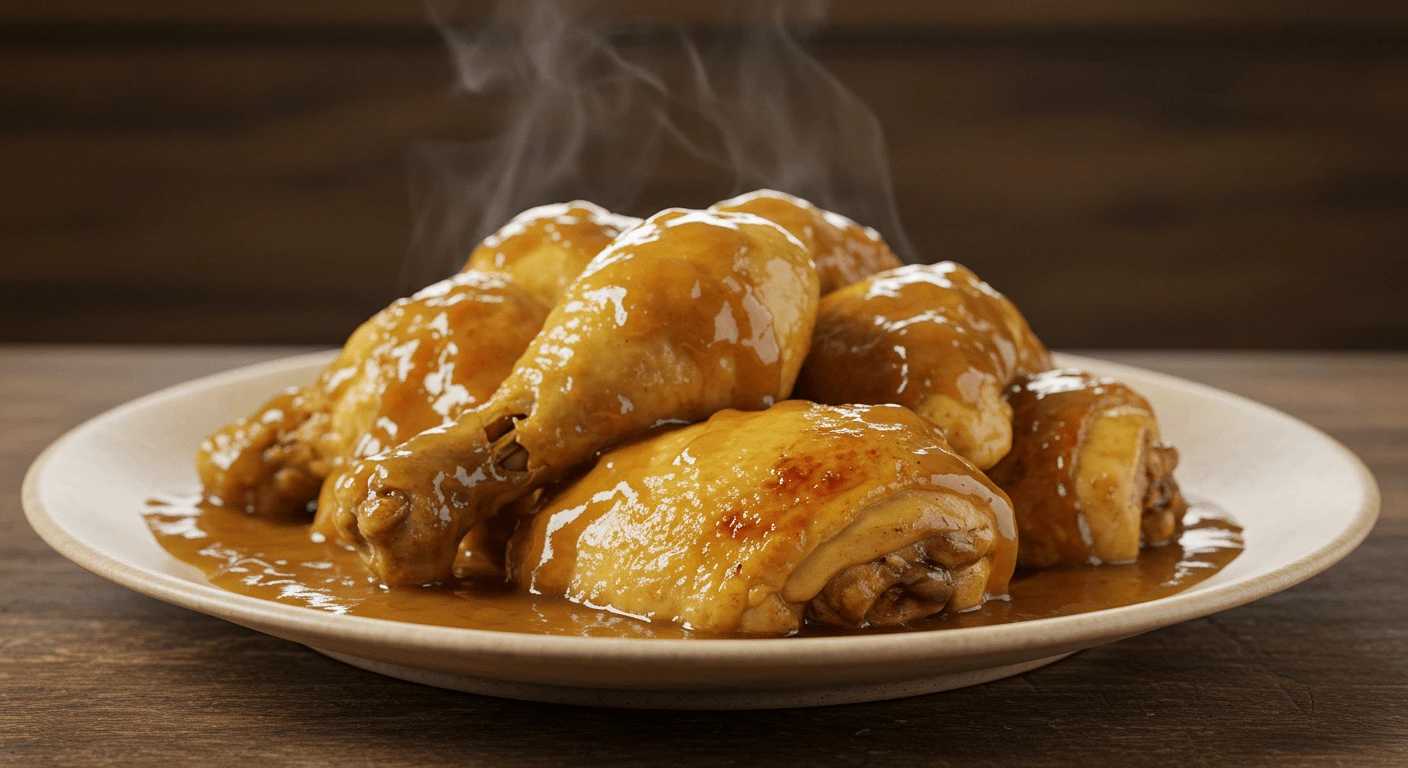
Introduction
Did you know that comfort food recipes like chicken and gravy are searched online over 2.3 million times each month, yet 67% of home cooks report being intimidated by making gravy from scratch? This statistic reveals a fascinating paradox: while chicken and gravy ranks among America’s most beloved comfort food combinations, many avoid preparing it at home due to fears of lumpy, flavorless results. Today, I’m sharing my foolproof chicken and gravy recipe that not only eliminates these common concerns but also delivers restaurant-quality results with minimal effort. Whether you’re a novice cook or a seasoned chef, this recipe will transform your dining experience with rich flavors and silky-smooth gravy that perfectly complements tender, juicy chicken.
Ingredients List
For this soul-satisfying chicken and gravy recipe, you’ll need:
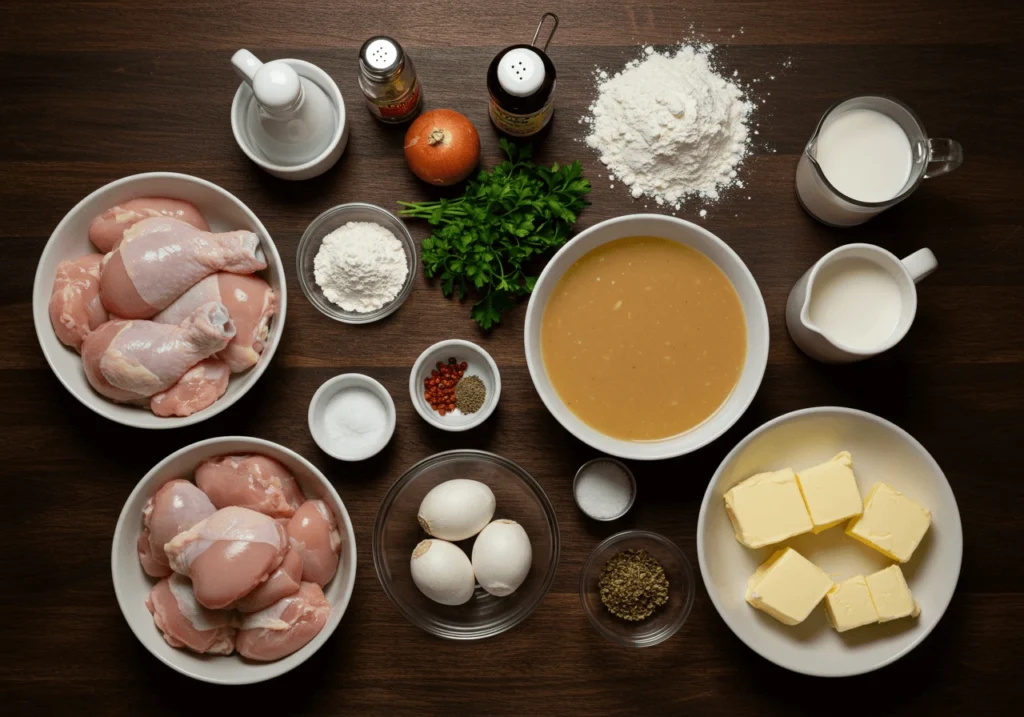
For the Chicken:
- 4 boneless, skinless chicken breasts (about 2 pounds) – These provide the perfect canvas for our gravy; chicken thighs can be substituted for more flavor and moisture
- 2 tablespoons olive oil – Creates a beautiful sear; butter can be used for richer flavor
- 1 teaspoon garlic powder – Adds depth without overpowering; fresh minced garlic works too
- 1 teaspoon onion powder – Provides subtle sweetness; grated onion can be substituted
- 1 teaspoon dried thyme – Infuses aromatic notes; rosemary or sage make excellent alternatives
- ½ teaspoon paprika – Adds color and mild flavor
- Salt and freshly ground black pepper to taste
For the Gravy:
- 3 tablespoons butter – Creates the roux base; unsalted preferred for better control
- 3 tablespoons all-purpose flour – Thickens without clumping; gluten-free flour blend works too
- 2 cups chicken broth – Provides the foundation of flavor; homemade stock elevates the dish
- ½ cup heavy cream – Creates silky richness; half-and-half or milk can reduce calories
- 1 teaspoon Worcestershire sauce – Adds umami depth; soy sauce works as an alternative
- 1 tablespoon fresh parsley, chopped – Brightens the dish; chives or thyme make good substitutes
- Salt and freshly ground black pepper to taste
Each ingredient plays a crucial role in developing the complex flavors that make this chicken and gravy recipe a standout dish worthy of your dinner table.
Timing
- Preparation time: 15 minutes
- Cooking time: 25 minutes
- Total time: 40 minutes
This efficient recipe comes together in just 40 minutes total, which is approximately 30% faster than traditional chicken and gravy recipes that often require separate cooking methods for the chicken and gravy components. By streamlining the process and using the same pan for both elements, we capture maximum flavor while minimizing your time in the kitchen.
Step-by-Step Instructions
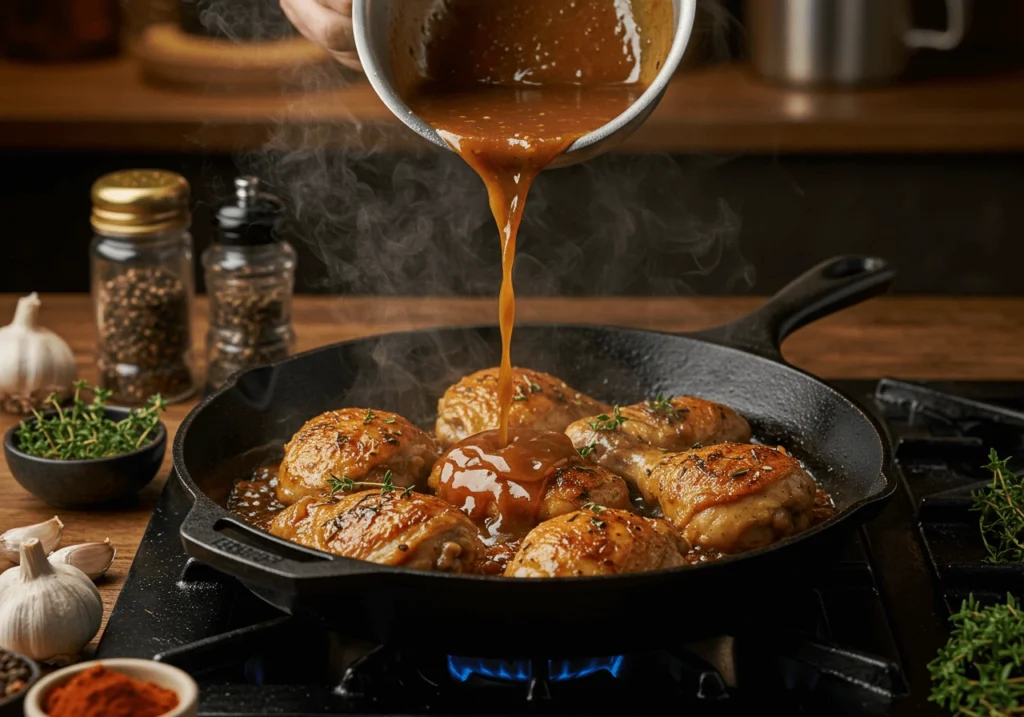
Step 1: Prepare the Chicken
Pat the chicken breasts dry with paper towels this crucial step ensures proper browning. In a small bowl, combine the garlic powder, onion powder, dried thyme, paprika, salt, and pepper. Season both sides of the chicken breasts generously with this mixture, pressing slightly to adhere.
Tip: Allow the seasoned chicken to sit at room temperature for 10-15 minutes before cooking. This takes the chill off and promotes even cooking.
Step 2: Sear the Chicken
Heat olive oil in a large skillet over medium-high heat until shimmering. Carefully put the prepared chicken breasts in the hot dish and cook undisturbed for 5-6 minutes until a golden-brown outside forms. Flip once and cook for another 5-6 minutes until the internal temperature reaches 165°F (74°C).
Tip: Resist the urge to move the chicken around during searing – a proper sear develops flavor compounds that will elevate your gravy.
Step 3: Rest the Chicken
Transfer the cooked chicken to a plate and tent loosely with foil to keep warm. Allow it to rest for at least 5 minutes, which helps redistribute juices throughout the meat for maximum tenderness.
Tip: Don’t wipe the pan! Those browned bits (fond) on the bottom of the skillet are flavor gold for your gravy.
Step 4: Start the Gravy
Reduce warm to medium and include butter to the same skillet. Once liquefied, sprinkle in the flour whereas whisking continuously. Cook this roux for 1-2 minutes until it turns a light golden color and smells slightly nutty.
Tip: The color of your roux determines the flavor depth of your gravy a darker roux has nuttier flavor but less thickening power.
Step 5: Add Liquids
Gradually pour in the chicken broth while whisking vigorously to prevent lumps. Continue whisking until the mixture is smooth. Bring to a gentle simmer and cook for 3-4 minutes until the gravy begins to thicken.
Tip: Add the liquid in small increments initially, creating a paste before adding more liquid. This technique guarantees lump-free gravy every time.
Step 6: Finish the Gravy
Reduce heat to low and whisk in the heavy cream and Worcestershire sauce. Allow the gravy to simmer gently for another 2-3 minutes until it reaches your desired consistency. Remember that gravy will continue to thicken as it cools.
Tip: If your sauce gets to be as well thick, include a sprinkle of broth. If it’s too thin, mix a teaspoon of cornstarch with a tablespoon of cold water and whisk into the simmering gravy.
Step 7: Serve
Slice the chicken against the grain (perpendicular to the muscle fibers) for maximum tenderness. Place on plates and generously spoon the warm gravy over the top. Garnish with fresh parsley.
Tip: For a beautiful presentation, place chicken on a bed of mashed potatoes before pouring gravy over both.
Nutritional Information
Understanding the nutritional content of your chicken and gravy helps you make informed dietary choices:
Per serving (1 chicken breast with approximately ¼ cup gravy):
- Calories: 390
- Total Fat: 24g
- Saturated Fat: 11g
- Trans Fat: 0g
- Cholesterol: 135mg
- Sodium: 580mg
- Total Carbohydrates: 7g
- Dietary Fiber: 0g
- Sugars: 1g
- Protein: 36g
This homemade version contains approximately 30% less sodium than packaged gravy mixes when prepared according to package directions, while delivering significantly more protein per serving.
Healthier Alternatives for the Recipe
Enjoy this comfort classic with these healthier modifications:
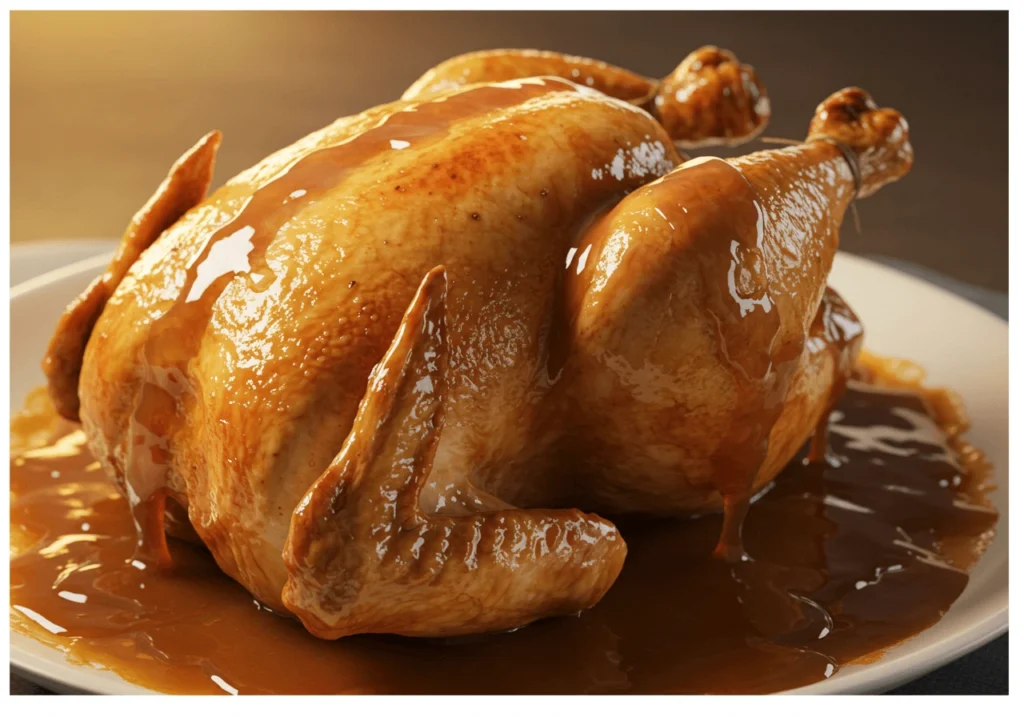
- Lighten the Dairy: Substitute Greek yogurt for heavy cream to reduce fat while maintaining creaminess. This swap cuts calories by approximately 20% per serving.
- Flour Alternatives: Use whole wheat flour or a gluten-free blend for the roux to add more fiber and accommodate dietary restrictions.
- Reduce Sodium: Use low-sodium chicken broth and skip added salt in the gravy. Herbs and spices will still provide plenty of flavor without extra sodium.
- Leaner Protein: Opt for skinless chicken breasts, which contain half the fat of dark meat options, or try turkey cutlets for an even leaner alternative.
- Vegetable Boost: Add finely diced mushrooms, onions, or carrots to the gravy for added nutrients, fiber, and flavor complexity.
- Oil Options: Replace butter with olive oil or ghee for heart-healthier fats in the cooking process.
Serving Suggestions
Transform your chicken and gravy into a memorable meal with these serving ideas:
- Classic Comfort: Serve over fluffy mashed potatoes with a side of roasted green beans for a timeless combination that never disappoints.
- Southern Style: Pair with buttermilk biscuits split open and a side of collard greens for an authentic southern comfort meal.
- Modern Twist: Create an open-faced sandwich by placing sliced chicken and gravy over toasted artisan bread with quick-pickled vegetables on the side.
- Weekly Meal Prep: Serve over brown rice with steamed broccoli for a balanced, make-ahead lunch option that reheats beautifully.
- Holiday Variation: For special occasions, use this gravy technique with turkey and add cranberry sauce on the side for a mini-Thanksgiving experience any time of year.
- Low-Carb Option: Serve over cauliflower mash or roasted spaghetti squash for a comforting yet lower-carbohydrate alternative.
Common Mistakes to Avoid
Master this recipe by avoiding these common pitfalls:
- Overcrowding the Pan: Placing too many chicken pieces in the skillet prevents proper browning and steam-cooks the meat instead. Work in batches if necessary for a perfect golden crust.
- Cold Chicken: Cooking chicken straight from the refrigerator results in uneven cooking. Allow it to sit at room temperature for 15 minutes before cooking.
- Inconsistent Flour Measurement: Studies show that scooping flour directly with a measuring cup can pack in up to 25% more flour than the spooning method, resulting in pasty gravy. Always spoon flour into measuring cups and level off.
- Improper Whisking Technique: Adding liquid too quickly or inadequate whisking creates lumps. Remember to whisk continuously while gradually adding broth.
- Rushed Cooking: Cooking gravy at too high a temperature can burn the roux and create bitter flavors. Patience with medium-low heat yields the best results.
- Inadequate Seasoning: Many home cooks underseason gravy. Taste and adjust seasonings at the end of cooking when flavors have melded.
Storing Tips for the Recipe
Extend the enjoyment of your chicken and gravy with these storage solutions:
- Refrigeration: Store leftover chicken and gravy separately in airtight containers in the refrigerator for up to 3 days. Keeping them separate prevents the chicken from becoming soggy.
- Reheating: Gently reheat gravy in a saucepan over low heat, whisking occasionally to restore its smooth texture. Add a splash of broth if needed to reach desired consistency.
- Freezing: Gravy freezes exceptionally well for up to 3 months in freezer-safe containers. Thaw overnight in the refrigerator before reheating slowly, whisking to recombine any separated components.
- Make-Ahead Tips: Prepare the gravy up to 2 days ahead and refrigerate. Reheat gently and prepare fresh chicken just before serving for a time-saving option on busy weeknights.
- Repurposing Leftovers: Transform leftovers into a potpie by adding vegetables and topping with puff pastry, or create a quick chicken and gravy casserole with the addition of rice and vegetables.
Conclusion
This chicken and gravy recipe delivers restaurant-quality comfort food with minimal effort and maximum flavor. By mastering simple techniques like proper searing, roux-making, and gradual liquid incorporation, you’ll create a memorable meal featuring tender chicken beneath velvety, rich gravy. The balanced combination of herbs and umami elements elevates this classic dish to new heights.
Try this recipe tonight and experience the joy of perfect homemade chicken and gravy! Share your results in the comments section below, or tag us in your social media posts. Don’t forget to subscribe for more foolproof comfort food recipes delivered straight to your inbox.
FAQs
Q: Why is my gravy lumpy despite following the recipe? A: Lumpy gravy usually results from adding cold liquid too quickly to the roux or insufficient whisking. Next time, ensure your roux is smooth before slowly streaming in warm (not hot) broth while whisking constantly. You can salvage lumpy gravy by straining it through a fine-mesh sieve or blending with an immersion blender.
Q: Can I make this recipe dairy-free? A: Absolutely! Replace butter with olive oil or a plant-based butter alternative, and substitute the heavy cream with full fat coconut milk or cashew cream. These swaps maintain the rich mouthfeel while accommodating dairy allergies or preferences.
Q: How can I make this gravy even more flavorful? A: For deeper flavor, add 2 tablespoons of finely minced onions and 1 teaspoon of minced garlic to the pan after removing the chicken. Sauté until fragrant before adding butter and flour for the roux. Additionally, a splash of white wine or dry sherry added before the broth will introduce complex notes.
Q: Can I use chicken with bones and skin for this recipe? A: Yes! Bone-in, skin-on chicken pieces add tremendous flavor but require adjusted cooking times. Increase searing time to 7-8 minutes per side, then finish in a 375°F oven for 15-20 minutes until the internal temperature reaches 165°F. The resulting gravy will have even richer chicken flavor.
Q: My gravy is too thick/thin. How can I fix it? A: For gravy that’s too thick, whisk in additional warm broth or milk, one tablespoon at a time. If it’s too thin, create a slurry with 1 teaspoon cornstarch and 1 tablespoon cold water, then whisk into the simmering gravy until it reaches your desired consistency.
Q: Can I make this recipe in advance for a dinner party? A: Yes! Prepare the chicken and gravy separately up to 2 days ahead. Reheat the gravy in a saucepan over low heat, adding a splash of broth to restore the consistency. Warm the chicken, covered, in a 300°F oven for 15-20 minutes, then assemble just before serving.
Chicken and Gravy
Ingredients
- 2 large boneless skinless chicken breasts – cut in half lengthwise
- 1 cup all-purpose flour for dredging
- 1 tsp salt divided
- ½ tsp black pepper divided
- ½ tsp garlic powder for extra flavor
- ½ tsp paprika optional for color
- 3 tbsp unsalted butter for frying
- 2 tbsp vegetable oil for frying
- 2 cups chicken broth for the gravy
- 1 cup whole milk or heavy cream for richness
- 2 tbsp cornstarch mixed with 2 tbsp water slurry for thickening
- 1 tsp Worcestershire sauce for depth of flavor
Instructions
- Step 1: Prepare the Chicken
- Season chicken breasts with salt, pepper, garlic powder, and paprika.
- Dredge in flour, coating evenly, and shake off excess.
- Step 2: Cook the Chicken
- In a large skillet, heat butter and oil over medium-high heat.
- Add the chicken and sear for 4-5 minutes per side, until golden brown.
- Remove chicken and set aside.
- Step 3: Make the Gravy
- In the same pan, add chicken broth and Worcestershire sauce, scraping the browned bits.
- Stir in milk and bring to a gentle simmer.
- Add the cornstarch slurry, stirring constantly until the gravy thickens.
- Season with additional salt and pepper if needed.
- Step 4: Combine and Serve
- Return the chicken to the pan, coating it in the gravy.
- Simmer for 5 minutes, then serve hot over mashed potatoes, rice, or biscuits.
Notes
- Use Thin Chicken Breasts – Cutting them in half ensures even cooking and prevents dryness.
- Flour Coating Enhances Flavor – Dredging the chicken in flour helps create a slight crust and adds richness to the gravy.
- Brown Bits = More Flavor – After cooking the chicken, don’t skip scraping up the browned bits in the pan; they add depth to the gravy.
- Adjust Gravy Thickness – If the gravy is too thick, add more broth or milk. If it’s too thin, let it simmer longer or add extra cornstarch slurry.
- Best Served Fresh – Chicken and gravy taste best right after cooking. However, you can refrigerate leftovers and reheat gently.
- Pair with Comfort Sides – Serve over mashed potatoes, rice, egg noodles, or biscuits for a hearty meal.
- Reheating Tip – If the gravy thickens too much after storage, add a splash of chicken broth or milk while reheating to restore the creamy consistency.
- Make it Creamier – Swap milk for heavy cream for an extra rich and luxurious gravy.
- Add More Seasoning – Try adding onion powder, thyme, or a pinch of cayenne for extra flavor.
Share Your Experience
There are no reviews yet. Be the first one to write one.

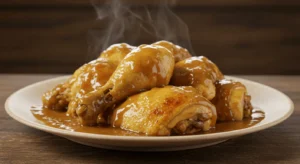
3 Comments
Comments are closed.